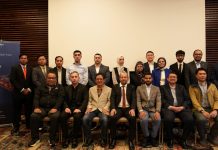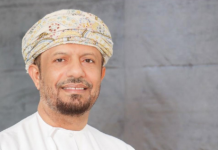Greg Young, CEO, Ooredoo Oman shares his views on the telecom major’s rebranding, future growth and what lies in store in the year ahead.
Ooredoo Oman rebranded itself in September October 2014. How has the rebranding been received by the market?
We have been extremely happy by the way our rebranding has been received. It was something that we did with a certain level of trepidation as taking a very well known and loved brand that was associated with change in the telecommunications industry in Oman and for its prompt responsiveness to customer needs, was a risk. We executed the change well and it has been received positively and wholeheartedly. We measure our brand responsiveness using traditional methods like market research and we have compared it to other operating companies within our group. I am pleased to share that since the rebranding, we have outperformed almost all our peers, regarding the level of brand equity and understanding within the community of the values that the brand stands for. Overall, it has been an extremely successful rebranding for us. The uptake in our business has been very pleasing and built upon the foundation of the rebranding activity. We have seen a 10 per cent increase in our customers over the last ten months. We have seen very significant increases in our ongoing revenues and other profitability indicators. The money that we invested in the rebranding has definitely been returned. This is an ongoing journey and we have had a very successful first year.
As you mentioned building a brand is an ongoing journey. How much of that distance have you covered and what is the roadmap for 2016?
We have clearly established a brand that has all the wonderful attributes that the brand had under the Nawras brand and the respect of our customer base. The first part was to establish the linkage and that has been established successfully. This was not a change of ownership or direction but about introducing a new brand that leverages the strengths that we have as a group and the relationships that we have with other operating companies, to bring benefits to our customers. It’s an ongoing process and we have to build more equity into the brand. It is important that every person in Oman understands as to what we stand for, because at the end of the day a brand is not about the visual imagery but what messages it conveys to customers or potential customers and their understanding about what a brand stands for. We are working on a new range of products and services, which we will soon bring to the market. These will be the build up to our momentum in 2016. We launched our superfast fibre to the home service in August 2015, we are now rolling it out to a much greater area, before the end of the year, a number of other areas will be able to get this superfast fibre. In September we completed the transition of our customers from the older wireless WiMAX home broadband service to the new LTE based service. We are seeing extremely strong demand from customers for home broadband, which we are delivering either using our superfast fibre, wherever it is available to the home or our LTE wireless home broadband service. So those are some of the customer impacting ways that we have been investing in our network and new products and services.
As the voice market gets saturated where do you see your future growth coming from?
Ooredoo Oman’s average revenue per user (ARPU) has gone up a little, during 2015. What we have seen is a very significant shift towards data. During the third quarter of 2015, blended mobile data revenues accounted for 45 per cent of our total mobile revenue. Within a customer’s monthly spend, data is becoming a more significant part. So our increased revenues are coming from various sources, increasing usage and better ARPU’s and ongoing customer growth. The other pleasing thing is that we are seeing growth in all parts of our business — consumer home broadband, mobile customers, data usage, B2B enterprise, very significant double digit growth in the government business, large corporate customers, SME’s, likewise we have seen a growth in the international calling market and good growth for international roaming, both outgoing and incoming.
For incoming we are seeing increasing data roaming, all people who are coming into the country are continuing to use their data roaming. We have an increased roaming facility with a larger number of operators and countries so a larger number of customers can use LTE as they would do at home. We also introduced in the last year a product called ‘roam like home’, which is available right now for our customers when they go to the UAE. This provides customers with greater certainty about the costs when they are roaming. They can pay a flat fee while they are out of the country and it provides them with data and other benefits. It also overcomes the fear of a large bill due to data usage. This is cost effective and provides customers with control over costs.
What is your next big leap that customers can look forward to?
The next big leap is definitely fibre to home. In the short term that is the investment that we are making as we believe that it will bring huge benefits to customers. The total fibre related investments made by Ooredoo Oman is around RO70mn. This is in addition to the spend on network modernisation which was at RO124, over the last three years. The capability and capacity that they get from fibre is better than what a wireless technology can deliver. The wireless technologies are excellent and they have a place in the market and they serve many of the customers very well, but they have limited capacity ultimately, particularly for those highly intensive household applications, that’s clearly one area for fixed broadband access for customers. The other one is 4G LTE and the heavy commitment that we are making is in rolling out 4G across Oman. We recently purchased new spectrum from the regulator, this new spectrum is lower frequency that means bigger footprint and better coverage inside buildings and with this we will be able to provide not just comparable but better coverage than 3G. Those are the two big areas – giving much higher data speeds and better in building coverage footprint for 4G LTE for mobile use and then for home use the superfast fibre.
It is said that people do not stop talking, irrespective of the business cycles. Does that insulate the telecom industry from an adverse impact, in a low oil price environment?
We have not seen any change in usage behaviour amongst our customers, we have also not witnessed a change in the usage of our telecom services. I think we will continue to see strong demand for it. The challenge that we foresee is that if there is a slowdown or scaling back of investment in projects by the government or private sector companies, then it will potentially reduce the size of the expatriate workforce population, which will have a direct influence on our services and that’s something that we are watching quite closely. We have seen strong demand from our enterprise customers and they are looking at increasing efficiencies in their operations and we are watching that space, but as of now we have not seen any reduction in demand from their end.
What in your opinion will be the big trends of 2016 in Oman, regionally or globally?
Today, we live in a connected world, which links everything and everyone. This means that we need to continue to provide affordable connectivity to all. Smartphones and ‘wearable’ devices are becoming commonplace and will soon govern many aspects of our lives, not just the social aspects, but economic, cultural and educational.
We are likely to see the growth of ‘smart communities’ and ‘smart cities’ in the not-too-distant future. For example, a ‘smart watch’ that tells you when your next medical is due, cars which communicate with the workshop when there’s a problem or where sensors can help determine available parking spaces and alert the driver as to where to best find available parking. We may even have traffic flow sensors to help monitor vehicle flows and improve road planning. Such technologies will be used everywhere where a mobile network is available.
There are already a number of initiatives to support the digitisation of a number of sectors, including e-commerce, financial services, health, education and even energy consumptions. These will very soon become an almost expected yet invisible part of everyday life, if they are not already.
Our role is to develop new services and platforms that can use such technology and support them by providing a strong and available network. Our network already covers almost 99 per cent of Oman’s population and will increase over time.
Greg Young shares his views on Ooredoo’s future growth
To report this post you need to login first.






